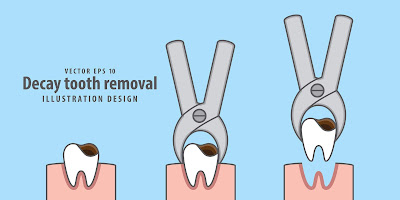Teeth pain is one of the most unbearable pain one has to go through. Avoiding the basic care one should take to keep their teeth healthy and clean will lead to an innumerable amount of complexities like cavities.
What Is Tooth Cavity?
Cavity refers to a hole in an object; hence dental cavities are nothing but gaps in the teeth or damage to the structure of a tooth. Dental cavities are also known as tooth decay. Cavities are tiny in initial stages but become more substantial if they are not treated.
Tooth sensitivity, tooth pain, visible hole in the teeth, black or white staining on the teeth are the symptoms of cavities. When food intake such as sugars is reacted with bacteria, it forms acids. This combination is known as plaque which sticks to the tooth due to its nature and acids in it gradually abrade the tooth enamel forming the cavities.
 |
| Dental Caries Or Tooth Decay |
Top 5 most recommended ways to treat tooth cavity are as follows:
Fluoride Treatments
The fundamental principle of fluoride treatment is to increase the resistance of teeth against the acid attacks of plaque. Fluoride treatment is one of the methods used by dentists to prevent decaying of the tooth and keep the teeth strong and healthy. The primary element of treatment, fluoride, is an essential tool in the prevention and reversal of decay.
The treatment involves highly concentrated rinse, foam, gel or varnish which is applied as a swab, brush, tray or mouthwash.
The fluoride content in the treatment is very high when compared to our municipal water or toothpaste.
Fillings
The filling is a way to fill the space or hole caused in the tooth due to cavities. This treatment brings the tooth back to its normal function and shape. The material to be filled includes gold, porcelain, a composite resin (tooth colored fillings) and amalgam (an alloy of mercury, silver, copper, tin and sometimes zinc).
The filling to be used depends on:
- Place of filling: Composite (plastic) resins are preferred to amalgam (silver fillings) for the front teeth because of their color, i.e., amalgam is of dark color and may not look good in front teeth whereas composite resins are of the same color as the teeth.
- The response of the patient to the filling: Some patients may have allergies towards certain metals used for filling, and hence the type of fillings differs person to person.
Crowns
A tooth-shaped "cap" that is placed over a tooth is known as the dental crown. This crown is planted on the tooth to bring back its natural shape and size, power and enhance its appearance. It is recommended as the best procedure to save a tooth; This is placed when 3/4th of the tooth is damaged because of cavities.
There are many advantages of placing a crown like:
- It protects a weak tooth from breaking.
- It keeps the parts of a cracked tooth intact.
- It covers and supports a tooth with a large filling when the tooth is hardly left.
- It covers severely discolored teeth.
Crowns available are of stainless steel, metals, porcelain-fused-to-metal, all-resin, all-porcelain or all-ceramic.
Root Canals
A decayed or infected tooth is repaired through root canal treatment where the nerve and the pulp are extracted, and the core of the tooth is cleaned and sealed.
Root canal in the term root canal treatment refers to the natural cavity present in the center of the tooth. The pulp or pulp chamber is the smooth space within the root canal. Decay or repeated dental procedures on the root can irritate and infect a tooth’s nerve and pulp.
Root canal treatments are reported to be painful. The success rate of root canal treatment is high, i.e., 95%. Many teeth which are fixed with a root canal can last a lifetime.
Tooth Extraction
Tooth extraction is complete removal of a tooth. The only other method to a root canal procedure is having the tooth extracted and replaced with a bridge, implant removable partial denture.
 |
| Tooth Extraction Or Removal Of The Decayed Tooth |
There are two types of tooth extractions. They are:
- Simple extraction: This is a routine way of tooth extraction which is practiced for those whose teeth have already erupted and present with minimal complications.
- Surgical extraction: Teeth broken at the gum level or teeth with curved roots are removed through this method. The bone which is present next to the tooth is removed to extract the tooth.
Dr. Roman Fedorciw, a renowned Berlin dentist, highly recommends the E4D Dentist system, which enables to prepare and fabricate crowns of superior strength and aesthetics in one day also to take care of teeth every single day to avoid any complexities in future.
Any of the above treatment can cure the tooth decay and are highly successful until today.




I started on COPD Herbal treatment from Ultimate Health Home, the treatment worked incredibly for my lungs condition. I used the herbal treatment for almost 4 months, it reversed my COPD. My severe shortness of breath, dry cough, chest tightness gradually disappeared. Reach Ultimate Health Home via their email at ultimatehealthhome@gmail.com . I can breath much better and It feels comfortable!
ReplyDelete